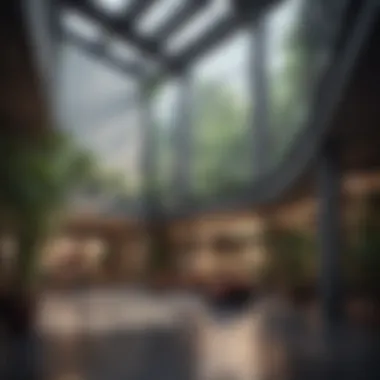The Aesthetic and Functional Appeal of Raised Ceilings


Intro
Raised ceilings represent a distinctive element in architectural design that bridges aesthetics and function. This structural feature is not merely about height; it embodies a dialogue between spaciousness and intimacy, lighting and shadow, form and purpose. In exploring raised ceilings, we examine their profound influence on spatial dynamics, which can transform an ordinary space into something extraordinary.
Several factors contribute to the growing popularity of raised ceilings in various environments, including residential homes, commercial buildings, and public spaces. Architects and designers increasingly recognize these elements for their versatility and deep impact on the overall ambiance of a setting. In this exploration, we will survey notable styles, materials, and practical considerations that accompany raised ceilings, aiming to inform and inspire real estate enthusiasts, travel lovers, and interior design aficionados alike.
By delving into the various dimensions of raised ceilings, we aim to provide comprehensive insights that underscore their aesthetic allure and functional benefits. As we proceed, we will highlight key points surrounding design, ambiance, and practical tips for implementation and upkeep. This affords us a deeper understanding of how raised ceilings can reshape environments, making them more inviting and visually impactful.
Prelude to Raised Ceilings
Raised ceilings have garnered significant attention in architectural design and interior aesthetics. Their unique ability to alter perceptions of space is both aesthetic and functional. Understanding raised ceilings is paramount for designers, architects, homeowners, and even real estate enthusiasts, as they can impact ambiance, style, and market value.
One of the core benefits of raised ceilings is the visual openness they create. By allowing an increased vertical dimension, rooms not only appear larger but induce a sense of airiness. The added height can work wonders in smaller spaces, transforming confined quarters into inviting environments. Additionally, such ceilings can serve as a canvas for various design styles, enhancing overall home appeal.
Considerations involve not just the aesthetic but the functional aspects as well. Raised ceilings can influence factors like lighting and acoustic performance. Proper design choices can maximize natural light entry, elevating the mood of any room. However, they also can present challenges, such as increased heating and cooling requirements or potential noise issues.
In essence, raised ceilings represent a confluence of style and practicality, integrating seamlessly into diverse settings—residential homes, commercial spaces, and even public venues. As we explore this subject further, we will delve into defining raised ceilings and their historical context.
Defining Raised Ceilings
Raised ceilings refer to ceilings that are positioned significantly higher than standard ceiling heights, often exceeding nine feet. These ceilings may be achieved through specific designs or architectural features like vaulted ceilings, coffered designs, or even trays. The distinction lies within how elevated ceilings can create different moods or functionality. The effect is not only visual but also tangible, influencing how occupants interact with the space.
Overall, this concept extends beyond just a mere rise in height; it embodies an enhancement in atmosphere, perception, and spatial dimensions.
Historical Context
The evolution of raised ceilings can be traced throughout architectural history. Initial usage can be seen in grand cathedrals and palatial residences. These structures utilized lofty heights to inspire awe and display architectural prowess. The Renaissance period, for instance, showcased the elegance of high ceilings adorned with intricate frescoes and moldings, enhancing both beauty and acoustics.
As we progressed into the 19th century, Victorian styles embraced a variety of ceiling techniques. These innovations included ceilings that were not only raised but often elaborately designed, finding their way into public institutions and opulent homes alike.
In contemporary settings, the popularity of raised ceilings continues. They are embraced across various design movements, demonstrating versatility and ongoing relevance in modern architecture. The appeal remains—an invitation to experience greater space, light, and beauty, affirming that raised ceilings are not merely structural components but also integral to our lived experience.
Aesthetic Considerations
The aesthetic appeal of raised ceilings is significant when considering the overall design of a space. It provides an opportunity to enhance visual interest and create a sense of elegance. Raised ceilings can also change the psychological perception of a room. It often makes areas feel larger and more open, allowing for a more inviting environment. When thoughtfully integrated, they help to balance proportions and can effectively draw attention to key design elements within a space.
Creating Visual Space
Raised ceilings increase the perceived volume of a room. When walls extend upward, the space feels less confining. This perception impacts how individuals interact within that space. The airy quality evokes a feeling of freedom which can be especially important in areas meant for socializing or relaxation. Furthermore, taller walls provide more opportunities to showcase artwork or architectural details, such as intricate molding or structural beams.
In a practical sense, the increase in vertical space opens avenues for creativity in decor. Light fixtures can hang lower, creating focal points, while wall decorations can ascend higher, taking advantage of the ample space. Decorative elements can include oversized chandeliers, which can serve as statement pieces, thus elevating the whole aesthetic of the room.
Design Styles that Benefit
Modern
The modern design style embraces clean lines and minimalist aesthetics. In this context, raised ceilings are particularly beneficial due to their capacity to complement simplicity. The key characteristic of modern design is its emphasis on open spaces and functionality. Raised ceilings amplify this idea, providing a sense of expanse without overwhelming clutter.
A unique feature of modern designs is the use of materials like glass, metal, and monochromatic color schemes. These elements can enhance the effect of elevated ceilings, creating a seamless flow. However, the challenge may arise in achieving a balanced look without making the space feel too stark or empty.


Traditional
Traditional design is characterized by warmth and rich colors. Here, raised ceilings contribute to a grand and timeless aesthetic. The key aspect is the opportunity for ornate details, like crown molding or coffered designs. Such ceilings can serve as a nostalgic nod to historical architecture, enriching a home's character.
A specific feature prevalent in traditional spaces is the use of chandeliers and rustic wooden beams. These elements can enhance the elevated aspect of the ceiling while not losing the inviting quality. The potential downside lies in the risk of feeling cluttered if too many decorative items are layered upon the ceiling.
Industrial
The industrial design style highlights raw elements and functionality. Raised ceilings typify the open floor plans found in warehouses. The key characteristic here is the emphasis on materials like exposed brick and metal. These designs thrive on visible structures, making raised ceilings an ideal choice for creating dramatic contrasts in materials.
This style often utilizes large-scale lighting fixtures and pipes as a part of the design, which can accentuate the height of the ceilings. Nevertheless, the challenge lies in maintaining warmth and comfort without compromising the style's essence. Achieving a balance between a stark industrial look and a livable environment is crucial for success in such spaces.
Functional Benefits
In the realm of architecture and interior design, functional benefits of raised ceilings are often a critical aspect that informs decisions. These ceilings attract homeowners and designers not only for their aesthetic appeal but also for their ability to enhance the functionality of a space. Understanding the functional advantages can lead to informed choices that ultimately improve the living or working environment.
Improved Air Circulation
One significant functional benefit of raised ceilings is improved air circulation. Higher ceilings allow hot air to rise, creating a natural convection effect. This design aspect is particularly advantageous in regions with warm climates. When air convection occurs, the cooler air can flow in from lower areas, promoting a comfortable indoor climate.
Furthermore, in spaces like living rooms and kitchens, which often experience variations in temperature due to cooking or heating, raised ceilings can contribute to a more stable environment. Various ventilation systems can also work more efficiently in spaces with elevated ceilings. This means improved air quality and comfort for occupants.
Natural Lighting Enhancement
Another essential benefit is natural lighting enhancement. Raised ceilings can significantly increase the amount of ambient light in a room. Higher ceilings allow for larger windows or skylights, which can flood the space with natural light.
This feature not only makes living spaces feel more open and airy but also contributes positively to mood and mental well-being. Natural light can reduce the reliance on artificial lighting, which can save on energy costs. In spaces intended for social interaction, like living rooms or cafes, enhanced natural lighting creates an inviting atmosphere for gatherings.
"The combination of raised ceilings with natural light can transform ordinary spaces into extraordinary experiences."
In sum, the functional benefits of raised ceilings are profound. Improved air circulation and enhanced natural lighting are just a couple of aspects that offer both comfort and efficiency. Considering these benefits helps create designs that are not just visually appealing but also practical.
Materials and Techniques
Understanding materials and techniques is vital when discussing raised ceilings. The choice of materials directly influences not only the aesthetics but also the functionality of the space. Proper techniques ensure that the ceilings not only look good but also meet the demands of structure and acoustics. Additionally, knowing which materials work best can guide homeowners, designers, and builders in creating environments that are both inviting and practical.
Ceiling Types
Vaulted
Vaulted ceilings are designed to create an upward arch, which is both visually striking and functionally advantageous. Their primary characteristic is the elevation that enhances a sense of openness in a room. This architectural feature can make smaller spaces appear larger. One key benefit of vaulted ceilings is their ability to improve natural light distribution, as they can be designed to allow more windows or skylights. However, they can also pose challenges with heating and cooling efficiency, requiring careful consideration during design.
Coffered
Coffered ceilings incorporate a series of recessed panels that create depth and texture. This design not only draws the eye upward but also adds a touch of elegance to interiors. The main advantage of coffered ceilings is their versatility; they can be crafted in numerous styles to complement various interior designs. However, installing coffered ceilings can be more labor-intensive and expensive than simpler ceiling types, which may discourage some homeowners.
Tray
Tray ceilings feature a center panel that is slightly higher than the surrounding edges, offering a unique depth perception. This type of ceiling is popular for its subtle sophistication and ability to define spaces within a room. Tray ceilings can be easily customized through different paint colors or materials to enhance their appeal. The primary downside is that they may require more thoughtful lighting design to avoid shadows, which can take away from their intended effect.


Finishing Options
Paint Choices
The color and finish of the paint on raised ceilings can dramatically change the perception of space. Lighter colors tend to create a sense of airiness, making a room feel more spacious. Darker colors, on the other hand, can add drama and warmth, but can also make a room feel smaller. One distinguishing feature of paint choices is the ability to easily update or change the feel of the space without major renovations or expenses. However, regular maintenance such as repainting may add ongoing costs.
Wood Beams
Exposed wood beams can enhance the character of raised ceilings. They provide a rustic charm and can complement both traditional and modern design schemes. The primary advantage of wood beams lies in their aesthetic appeal; they create a focal point in a room. However, wood is prone to warping or fading over time, which is a consideration for homeowners looking for lasting materials.
Lighting Fixtures
Lighting is crucial in accentuating raised ceilings. A well-placed chandelier or pendant light can enhance the feeling of height and draw attention to the ceiling design. Different styles of lighting fixtures can bring personality to the space; for example, modern fixtures complement minimalist designs while ornate chandeliers add sophistication. The main consideration is ensuring that the lighting is functional as well as decorative, as improper placement may create uneven illumination.
Installing raised ceilings requires careful planning and understanding of both materials and techniques. The right choices enhance not only the aesthetic appeal but also the functionality of the space.
Raised Ceilings in Different Spaces
Raised ceilings serve significant roles across various environments, influencing not only aesthetic appeal but also functionality. In residential and commercial architecture, these high ceilings create an impression of spaciousness, contributing to a more welcoming atmosphere. When exploring raised ceilings, one must consider how they interact with the overall design, air quality, natural light, and the psychological impact on occupants. The following sections will examine the distinct needs and benefits in specific types of spaces: living rooms, kitchens, and commercial environments.
Living Rooms
Living rooms are often termed the heart of a home, where families gather and entertain guest. Raised ceilings can elevate the experience of this space dramatically. The perception of height brings an airy feel, making a room less cramped. This effect can be accentuated by large windows or open floor plans that allow natural light to flood the area.
- A raised ceiling can accommodate various design elements like chandeliers or large ceiling fans, which steer attention upwards and create elegant focal points.
- The verticality enhances acoustics, which is crucial in spaces designed for social interactions.
- It can also provide an option for incorporating architectural details, such as molding or wood paneling, that enriches the room's character.
Kitchens
Kitchens, traditionally viewed as functional spaces, gain sophistication through raised ceilings. The benefits here are twofold: functionality and aesthetics.
- Higher ceilings allow for larger cabinets and more sophisticated storage solutions, enabling better organization and reducing clutter.
- The openness invites more natural light, resulting in a brighter, more inviting cooking space, essential for creative culinary endeavors.
- In addition, the height enhances ventilation, minimizing heat accumulation during meal preparation.
Overall, raised ceilings in kitchens ultimately make the space not just practical but visually alluring.
Commercial Spaces
In commercial spaces, the application of raised ceilings varies significantly by industry and intention. Retail, office, and hospitality sectors can utilize high ceilings to convey different perceptions.
- Retail: In stores, raised ceilings can create an impression of luxury and a more spacious shopping experience. This aspect can encourage longer visits, enhancing consumer engagement.
- Office: In work environments, it can improve air circulation and create a more pleasant atmosphere, which can lead to increased productivity among employees.
- Hospitality: In hotels or restaurants, raised ceilings evoke a sense of grandeur, enhancing the emotional experience of guests. This can be a key factor in customer satisfaction.
Each space presents unique advantages and challenges regarding raised ceilings. Strategic planning is essential to maximize both visual appeal and functionality for the intended audience.
Design Challenges
Raised ceilings offer undeniable aesthetic and functional benefits, but they also come with design challenges that must be addressed. Understanding these challenges is essential for creating a space that is both beautiful and livable. Designers, architects, and homeowners alike should consider how raised ceilings interact with other architectural elements and environmental factors. By focusing on issues such as acoustics and temperature control, one can ensure that these high ceilings contribute positively to the overall ambiance and usability of a room.
Acoustic Considerations
One significant challenge that arises with raised ceilings is the impact on acoustics. Taller ceilings can create echoes and sound distortions that disrupt the auditory experience within a space. Sound waves travel differently in larger volumes, which may make conversations difficult and create a less intimate atmosphere. This effect is particularly notable in large living rooms or open-plan spaces where soft furnishings are minimal. To counter this, several strategies can be employed:


- Incorporating Sound-Absorbing Materials: Adding rugs, curtains, and upholstered furniture can help absorb sound and minimize echoes. Materials such as acoustic panels or foam can also be installed on walls or the ceiling itself to help mitigate unwanted noise.
- Thoughtful Spatial Layouts: Arranging furniture to create defined conversation areas can help control where sound travels. Positioning sofas and chairs not only adds to the aesthetic but also aids in sound management.
- Choosing the Right Lighting Fixtures: Lighting fixtures that hang lower may help break up the height and disrupt sound waves, creating a more pleasant acoustic environment.
Implementing these strategies can enhance both the beauty and functionality of a space with raised ceilings, allowing for a harmonious balance between appearance and audio experience.
Heating and Cooling Effects
Another challenge associated with raised ceilings involves their effect on heating and cooling within a space. Higher ceilings create larger air volumes, which can make regulating temperature more difficult. This may lead to energy inefficiency and uncomfortable environments, especially during extreme weather conditions. There are a few considerations to take into account here:
- Heating System Design: Adequate planning of heating systems is crucial for rooms with raised ceilings. Options like ceiling fans and high-efficiency HVAC systems that distribute air evenly throughout the space can be beneficial. Furthermore, radiant heating systems can often be more effective in managing temperature in larger areas.
- Insulation Choices: Proper insulation is essential for temperature regulation. Insulating the roof and ceilings adequately can keep heat from escaping during cold months and prevent excess heat build-up in the summer. This will contribute to energy efficiency and comfort.
- Ventilation Solutions: Strategic placement of vents and windows can enhance airflow and help regulate indoor temperatures. Natural ventilation should be prioritized, with windows positioned to promote cross-ventilation.
Navigating these challenges requires thoughtful planning and design, but overcoming them leads to spaces that maximize both comfort and style. By addressing acoustic and heating/cooling considerations, raised ceilings can truly shine in any setting.
Cost Implications
When considering raised ceilings, cost implications play a crucial role in the decision-making process for homeowners and designers alike. An understanding of these financial factors can influence the feasibility of incorporating such architectural features into a project. Key areas of focus include budgeting for installation and evaluating the long-term value of the investment.
Budgeting for Installation
Installing raised ceilings often requires a significant upfront investment. Factors affecting this cost include the current structure, desired ceiling height, and chosen materials.
- Structural Modifications: Depending on the existing space, structural changes may be necessary to support higher ceilings. This may involve hiring a structural engineer, which adds to the overall cost.
- Material Choices: The type of materials used for finishing can greatly influence expenses. For instance, opting for natural wood beams will likely be pricier than using drywall.
- Labor Costs: Skilled labor may be needed for precise installation, especially if intricate designs like coffered or tray ceilings are desired. Skilled labor commands higher wages, thus affecting the total cost.
- Permits and Regulations: Depending on the jurisdiction, modifications may require permits. This can incur additional costs and delay the project.
The expenses can accumulate quickly. Therefore, proper budgeting is crucial.
Long-Term Value
Raised ceilings offer more than just aesthetic enhancement; they also can provide significant long-term value. While the initial investment may be higher, several factors contribute to this value over time.
- Improved Property Value: Homes featuring raised ceilings often attract higher resale values. Many buyers view them as a desirable feature, leading to increased demand in the real estate market.
- Potential Energy Savings: In some cases, raised ceilings can lead to better air circulation. Improved airflow may reduce the burden on heating and cooling systems.
- Longevity and Durability: Quality materials and proper installation contribute to the lifespan of the ceiling. This durability can mean lower maintenance costs in the future.
In summary, while raised ceilings require careful budgeting for installation, their long-term benefits can offer impressive returns. Opting for an investment in raised ceilings can enhance not only the immediate functionality and aesthetics of a space but also its overall property value.
Future Trends
Understanding future trends in raised ceiling design is vital for architects and homeowners who aim to stay ahead in the evolving landscape of architecture and interior design. As preferences shift and technology advances, there are notable trends that are taking center stage. These trends not only enhance the aesthetic appeal of spaces but also align with practical demands and innovative technologies.
Innovative Designs
The pursuit of innovative designs in raised ceilings reflects a growing emphasis on personalization and creativity. Unconventional shapes and finishes have become popular, moving away from the traditional flat ceiling. For instance, coffered and sculpted designs are rising in popularity. These bespoke ceilings accentuate a room’s character and offer unique visual interest, encouraging designers to explore diverse materials like metal and glass alongside wood and plaster.
Using technology, designers are now experimenting with integrated lighting solutions. LED recessed lighting can be strategically placed within multilayered ceilings, creating ambiance and depth. Another emerging trend is the use of floating ceiling panels. These panels can be suspended at varying heights, offering a dynamic visual effect while simultaneously managing acoustics.
Additionally, there is a rise in biophilic design elements where nature-inspired aesthetics are incorporated into raised ceilings. Natural light wells, combined with vertical gardens, contribute to better air quality and enhance the connection between indoor and outdoor environments.
Sustainability Considerations
Another important aspect to consider is sustainability, which is shaping future trends significantly. The architectural community is increasingly prioritizing sustainable materials in raised ceiling design. Reclaimed wood, bamboo, and recycled metals are gaining traction due to their low environmental impact compared to traditional building materials.
Additionally, energy efficiency plays a role in sustainability considerations. Designers are focusing on ceiling designs that enhance natural ventilation and light, minimizing the need for artificial heating and cooling. For example, utilizing clerestory windows within raised ceilings can maximize daylight without compromising privacy.
Moreover, certifications like LEED (Leadership in Energy and Environmental Design) influence project implementations. Homeowners and builders are encouraged to comply with eco-friendly standards when considering raised ceiling projects, ensuring long-term benefits not just aesthetically but also in terms of reduced energy consumption and maintaining a healthy environment.
"Incorporating sustainability into design is not just a trend; it is essential for the future of our living spaces."
By understanding these trends in innovative designs and sustainability, stakeholders can create spaces that not only meet the functional requirements but also resonate with the evolving aesthetic preferences of users.







